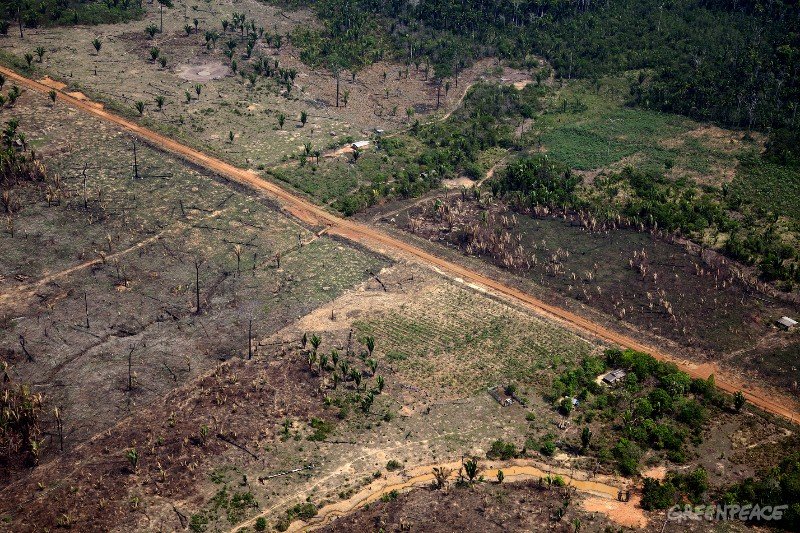

Desmatamento em Rondônia (Foto: Greenpeace)
Gatti, Luciana V.; Costa, Pedro; Arieira, Julia; Blackham, Grace; Alencar, Ane; Macedo, Marcia; Brown, Foster; Garavito, Sandra; Suruí, Gasodá; Silva, Sonaira; Verissimo, Beto; Hecht, Susanna; Saleska, Scott. Human Impacts on Carbon emissions e losses in ecosystems services: The Need for restoration and innovative climate finance for the amazon. The Amazon We Want, 2023. https://www.theamazonwewant.org/spa_publication/policy-brief-human-impacts-on-carbon-emissions-losses-in-ecosystem-services/
Key Messages
(i) Over the last decade (2010-2020), the Amazon carbon budget, integrating all absorption and emission processes, indicates that the region has become a carbon source – primarily due to land-use changes, representing an annual CO2 emission of 1.1 billion tonnes per year.
(ii) Deforestation and forest degradation spur regional climate change by inducing climate disturbances that severely compromise the remaining forests, reducing forest carbon uptake and storage, and affecting regional microclimates, provoking lower rainfall and higher surface temperatures, particularly during droughts, leading regions with >20% deforestation to approach their tipping point.
(iii) Extreme climate events in the Amazon, such as the super El Niño 2023-24, in combination with high temperature anomalies in the North Atlantic Ocean, exacerbate humandriven changes in the Amazon (i, ii), especially with the occurrence of mega-fires, threatening the wellbeing of Indigenous peoples and local communities (IPLCs) as well as those who live in its cities and towns. In 2023, Amazonian municipalities showed some of the worst air quality in the world due to regional fires, including Manaus, Santarém, and Santa Cruz de la Sierra.
(iv) Primary and secondary forests remove 0.7 billion tonnes of CO2 per year combined, which represents about 14% of all global sources associated with land-use change. The Amazonian forests act not only as carbon sinks, but also provide multiple ecosystem services, including: regulating the regional climate by recycling water to the atmosphere and reducing regional and local air temperatures,
supporting hydrological systems, conserving biodiversity, and supporting the livelihoods of IPLCs as well as urban populations.
(v) Ending all deforestation (legal and illegal) and preventing forest degradation can restore the Amazonian carbon sink, even in the face of global climate change. Implementing largescale forest protection measures would maintain the existing carbon stocks, while an advancing and ambitious program of forest restoration would capture and store an additional 15-30 billion tonnes of CO2 in Amazonian forests by 2050.
(vi) Carbon markets (i.e., transactions of carbon credits in exchange for carbon removals or storage) can provide part of the finance needed for forest protection and restoration in the Amazon, but most current models of carbon finance restrict the ability to grow to scale because the needs to ensure additionality, prevent leakage and promote permanence of carbon stocks at the individual level of projects or programs.
There is a need for innovation and alternative approaches in financing forest protection and restoration, focusing on a wider definition of climate and environmental finance that can be deployed at the landscape level and avoid the challenges of project or program-based approaches.
This post was published on 11 de dezembro de 2023
Título Fatos da Amazônia 2025 Autores Daniel Santos Manuele Lima Agatha Vilhena Beto Veríssimo Caíque…
Amorim, L., Ferreira, R., Dias, M., Souza Jr., C., & Veríssimo, A. Sistema de Alerta…
Título A Vocação da Restauração Florestal na Amazônia com Base na Vegetação Secundária Autores Jayne…
Amorim, L., Ferreira, R., Dias, M., Souza Jr., C., & Veríssimo, A. Sistema de Alerta…
Título Lições da Expansão da Pecuária Bovina no Brasil (2000-2023) para uma Produção Sustentável e…
Título Explosive growth of secondary roads is linked to widespread tropical deforestation Autores Jayden E.…